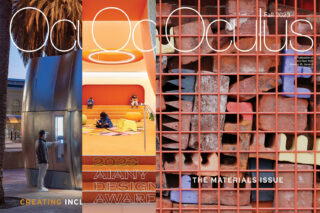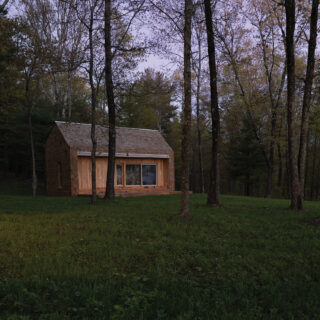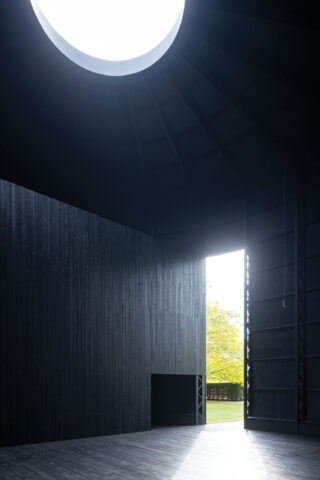“Thus it is an instance of technê when we cut down a tree to make lumber for a house, or logs for a fire, or paper for a book. From these admittedly commonplace examples we may derive all the essential principles of technê: that it is conscious, willful, materially violent, and materially productive. Interestingly, the ancient Greek word most commonly used to mean ‘matter’ or ‘material’ is hule, whose first meaning is simply ‘wood.’ This word in its ambiguity represents a missing link between the natural and the artificial. It points simultaneously back towards trees and ahead towards matter, thus revealing the passage from one to the other. Wood, halfway from tree to raw material, is still recognizably natural and yet is, in the multiplicity of its uses, a metaphor for all that is malleable. Wood is not what the architect sees either firstly or finally. First there is the tree and finally there is the house. In the meantime, there is wood.”
“This, then, is the core of human genius: to look at a forest and see not the trees but a village of houses or a fleet of ships…and then, of course, to materially realize one’s vision.“
—“Technê,” Robert Meagher, Perspecta: The Yale Architectural Journal (1988, New York: Rizzoli International Publications), p. 160
Several years ago, during a workshop organized for leaders in architecture and design—both practitioners and educators—the participants attending were asked at the outset to draw or diagram their understandings of “leadership,” as a means of introduction and as a prompt for further discussion. I drew an image of a forest. Throughout my life, across the years, across geographies, I have walked in forests: in the fir forests of the Pacific Northwest, and amid the aspens of the lower Rockies; through the sloped forests of the Blue Ridge and the Appalachians; in the birch forests of Finland and the deep spruce forests of Slovenia and Austria; and now in the oak, hickory, and pine forests of Arkansas. In hindsight, and with the limited foresight I possess, I believe that while “the forest” has been a consistent context, an unacknowledged background and setting for life and work, it has also offered a steadily growing “mental map”—a way of understanding the world, being oriented in the world, and providing abstract and specific lessons in work and life.
I make no claim to originality of thought or proposition. My friend and colleague, the Finnish architect and educator Juhani Pallasmaa, has written often of “a forest mentality,” one derived from one’s own experience of residing in the forest, but also from living within an entire culture residing in the forest, for generations, even millennia. The deep psychological structures of our being in the world (our perceptions of space, material, color, pattern, and proportion); our kinesthetic awareness of how we move through the world; and our valuation of what we make to use in the world, he argues, are profoundly affected by this sensibility.
For me, an educator in architecture and design, the proposition of “a forest mentality” has further ramifications for the essential work to be done in educating the next generation. If this moment is simultaneously a time of constrained or diminishing economic and environmental circumstances; a time of dynamic, expanding flows of people, products, finances, and information; and a time of intensifying struggles for racial and social justice, then the architects’ and educators’ tasks and responsibilities become problematic and vital. Amid these complex challenges, conceptual frameworks and guides for assessment, deliberation, and decision—for leadership, if you wish—possess great value. The proposition of “a forest mentality” as a useful, applicable conceptual framework for work in architectural education—and, by specific extension, for work focused on the architectural applications of mass timber and wood products—has value in at least three ways.
The first and primary value of the forest mentality is as a metaphorical proposition for a committed ethos of ecological thinking and working. By this I mean to assert not only the overt environmental agendas to be addressed, with ever greater urgency, in architecture and design, but also our need to comprehend the holistic implications of our choices in architecture and design. The organic, networked, interconnected relationships implicit in any design decision—certainly those addressing the complex challenges involved at any scale, from a spoon to a city—are best represented, in my view, by this image of a forest. Implicit in this assertion is the forest as an image of the interdisciplinary, collaborative, and interdependent education necessary for wise action within a complex context that includes the political, economic, and social processes of society. This is “ecological” thought and work at a grand scale, in the truest sense of the word “ecology”: “the totality or pattern of relations between organisms and their environment; an often delicate or intricate system or complex.” To live and work within the conceptual forest as an architect and designer, I propose, is to live and work within a creative ecology of thought, perception, and activity.
A second value of the forest mentality is as a metaphorical proposition for “the circular economy” in specific. Many have outlined the intellectual dimensions and practical applications of this important, even essential, approach to work in architecture and design, and our collective work in identifying the economic and environmental value of working across forestry, mass timber, and architecture is a direct demonstration of its potential. But here I want to suggest that the superlative refinement of that approach by economist Kate Raworth—her proposition of “the doughnut economy”—can best be represented spatially by the abstracted landscape of the forest. Raworth’s two-dimensional concentric circular diagram is described as “a twenty-first-century compass. Between its social foundation of human well-being and ecological ceiling of planetary pressure lies the safe and just space for humanity.” In the spatial experience of the forest, the varying terrain of our movement and activity—“the social foundation of human well-being”—is sheltered by the foliage and canopy of the trees—“the ecological ceiling.” The safe and just space for humanity, as she phrases it, lies in the space between the ground terrain and the forest canopy. To live and work within the conceptual forest as an architect and designer, I propose, is to live and work within the responsibilities and potentials of the in-between spaces of the forest, the space between the social terrain (foundation) and the ecological canopy (ceiling).
The third value of the forest mentality is as a proposition for our vision and imagination, for the wise exercise of human activity within and upon the forest, for the conversion of the forest to human use, and for our stewardship of the forest for future generations. This is “the core of human genius,” which philosopher Robert Meagher refers to as that capacity for technê, for the application of imaginative vision, and the labor and technique to materially realize that vision. Wise students of architecture know that the ethos of technê is intrinsic to their self-identity; in fact, it is embedded in the very name of “archi-tect.” The fundamental proposition here is that the imaginative vision is, at least in part, originally rooted and cultivated in a vision of the forest. Implicit in the assertion of technê and its origins in the forest, however, is that forest-centered vision is focused on more than immediate needs or desires. It is implicit that those who exercise it are doing so responsibly, with foresight and imaginative vision into the future, on behalf of others we may never meet, know, or live with contemporaneously. Historically, civilizations of the world have understood the forest to have both sacred and utilitarian character.
As an architect and a designer, I propose that to live and work within the conceptual forest is to live and work within the ethical landscape of our society and natural world, and to know deeply, with insight and foresight, the far-reaching responsibilities and compassionate qualities intrinsic to our profession.
Peter MacKeith, Assoc. AIA, has been the dean and professor of architecture at the Fay Jones School of Architecture and Design at the University of Arkansas since 2014. In that position, he’s been advocating for a low-carbon design and construction culture, specifically in the use of mass timber and related wood products, as an agenda for education from within a public land-grant university. He is currently overseeing the completion of an $80 million capital campaign for the school, and guiding the design and construction of the Anthony Timberlands Center for Design and Materials Innovation, a regional center for research and development of new wood products and approaches in sustainable construction materials. The project is being designed by Grafton Architects, the 2020 Pritzker Prize laureates.
















